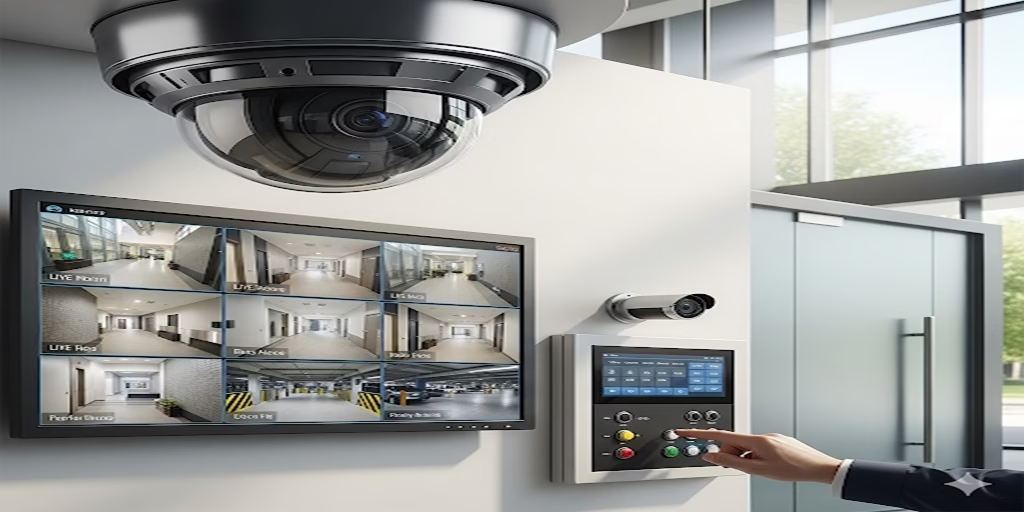How to Choose a Commercial Security Camera System?
Commercial Security Camera Systems Guide
In today’s fast-paced world, a reliable Commercial Security Camera System is no longer a luxury for businesses—it’s a necessity. From deterring theft and vandalism to improving operational efficiency and ensuring employee safety, a robust surveillance system is a powerful tool. But with so many options on the market, how do you choose the right one for your European business?
This guide will walk you through the essential factors to consider, from understanding different camera types to navigating legal requirements like GDPR. By the end, you’ll be equipped to make an informed decision that protects your business and gives you peace of mind.
1. Defining Your Business Security Needs
Before you start looking at cameras, you need a clear understanding of what you’re trying to protect. A small retail shop has very different needs from a large warehouse or an office building.
- What are your primary security concerns? Are you worried about shoplifting, employee theft, or unauthorized access? Do you need to monitor high-value assets or ensure compliance with safety protocols?
- What areas need coverage? Create a detailed map of your property, both indoors and outdoors. Identify key entry points, cash registers, server rooms, parking areas, and other high-traffic zones.
- What is your budget? Commercial security systems can range from a few hundred to tens of thousands of euros. Set a realistic budget that includes not only the initial hardware cost but also installation, maintenance, and potential subscription fees for cloud storage or advanced features.
2. Navigating the Legal Landscape: GDPR and European Regulations
This is arguably the most critical step for any business in Europe. The General Data Protection Regulation (GDPR) is a strict data privacy law that has a significant impact on how you can use a surveillance system. Failure to comply can result in hefty fines.
Here are the key points to remember:
- Lawful Basis for Processing: You must have a valid legal reason for collecting and processing video footage. The most common reason is “legitimate interest” in protecting your property and people, but this must be balanced against the privacy rights of individuals.
- Purpose Limitation: You must be clear about why you are using the cameras. For example, if you state the purpose is “crime prevention,” you cannot use the footage to monitor employee productivity unless you have a separate, explicit legal basis to do so.
- Data Minimization: Only record what is necessary. This means you should aim to minimize the recording of public spaces and be careful about where cameras are placed. Avoid placing them in areas where there is a high expectation of privacy, such as break rooms or restrooms.
- Transparency: You must inform people that they are being recorded. This is typically done with clear, visible signage at the entrance and within the monitored areas. The signs should include who is operating the system, the purpose of the recording, and a link to your privacy policy.
- Data Retention: You can’t store footage forever. You must have a clear policy on how long you keep the data. The general rule is to retain it for no longer than is necessary to fulfill the purpose for which it was collected. For most security purposes, this is a matter of days or weeks, not months or years.
- Security: You are responsible for protecting the recorded footage from unauthorized access. This means securing the network, using strong passwords, and restricting who has access to the video feed and stored data.
Before you make a purchase, it’s highly recommended to consult with a legal professional to ensure your specific use case is fully compliant with GDPR and any local or national laws that may apply.
3. Key Features and Technical Specifications to Consider
Once you’ve defined your needs and understand the legal framework, you can dive into the technical details.
Camera Types
The type of camera you choose will depend on the area you’re monitoring.
- Bullet Cameras: These are long, cylindrical cameras that are highly visible and often used outdoors. Their design makes them a great deterrent, and they are excellent for monitoring specific, long-range areas like a car park or the front of a building.
- Dome Cameras: Shaped like a dome, these cameras are more discreet and are difficult for people to tell which direction they are pointing. They are a popular choice for indoor areas like retail spaces and offices. Some are also vandal-proof (IK-rated), making them suitable for high-risk outdoor areas.
- PTZ (Pan-Tilt-Zoom) Cameras: These cameras can be remotely controlled to pan horizontally, tilt vertically, and zoom in on specific details. They are ideal for covering large, open spaces like warehouses or factory floors, as a single PTZ camera can do the job of several fixed cameras.
- Fisheye/360-Degree Cameras: These offer a panoramic, 360-degree view from a single camera. They are perfect for providing a full overview of a large room without any blind spots, such as a large retail floor.
Video Quality and Resolution
Higher resolution means more detail, which is crucial for identifying faces, license plates, and other important information.
- Full HD (1080p): A good standard for most general surveillance needs. It offers a clear picture that is sufficient for most purposes.
- 4K (8MP or higher): This is the new standard for professional-grade systems. It provides incredibly sharp images, allowing you to digitally zoom in on a specific area of the frame without a significant loss of quality. This is particularly useful for evidence collection.
Connectivity
How the cameras connect to your network and power source is a major factor in installation and reliability.
- PoE (Power over Ethernet): This is the preferred method for most commercial installations. A single Ethernet cable provides both power and data connectivity to the camera, simplifying installation and reducing cabling. It’s highly reliable and secure.
- Wireless (Wi-Fi): Wireless cameras are flexible and easy to install, but they are not always the best choice for a large commercial setting. They can be susceptible to signal interference, and you still need a power source nearby. Wireless cameras may also pose a greater cybersecurity risk if not properly secured.
Storage
Where your video footage is stored is a critical decision.
- Local Storage (NVR/DVR): A Network Video Recorder (NVR) or Digital Video Recorder (DVR) is a physical device that stores footage on-site. NVRs are used for IP cameras, while DVRs are for older analogue systems. This gives you complete control over your data but requires you to manage the hardware, including hard drives.
- Cloud Storage: Footage is uploaded and stored securely on a remote server. This offers the flexibility of remote access and protection against on-site damage or theft of the storage device. However, it requires a stable, fast internet connection and often comes with recurring subscription fees.
- Hybrid Systems: Many modern systems combine both local and cloud storage, giving you the best of both worlds—local redundancy and off-site backup.
4. Advanced Features and Software
The true power of a modern security system lies in its software and advanced features.
- Video Analytics: AI-powered analytics can turn your surveillance system from a passive recording tool into a proactive security asset. This includes:
- Motion Detection: Notifies you when movement is detected in a specific zone.
- Object Recognition: Can distinguish between people, vehicles, and animals, reducing false alarms.
- Facial Recognition: Used for access control or identifying known individuals (note: this is heavily restricted by GDPR and should be used with extreme caution and legal consultation).
- License Plate Recognition (LPR): Automatically reads and records vehicle license plates, ideal for monitoring vehicle access to a property.
- Remote Access and Management: A good system will have a user-friendly app or web interface that allows you to view live feeds, review footage, and manage your system from anywhere in the world.
- Integration with Other Systems: Consider a system that can integrate with other security measures, such as access control, alarms, or smart lighting.
5. The Installation Process
Choosing the right system is only half the battle. Professional installation is essential to ensure the system works as intended.
- Hire a Certified Professional: A professional installer will have the expertise to place cameras strategically, run cables neatly, and configure the system correctly. They can also ensure that the installation complies with local regulations and building codes.
- Network Security: Your security camera system is a connected device, and it’s a potential entry point for cyberattacks. The installer should use strong passwords, secure network configurations, and ensure the system is on a separate, dedicated network if possible.
- Maintenance Plan: Discuss a maintenance plan with your installer. This should include regular checks, software updates, and cleaning of camera lenses to ensure the system remains reliable over time.
Conclusion
Choosing a commercial security camera system for your European business is a significant investment that requires careful consideration. It’s about more than just buying cameras; it’s about creating a comprehensive security strategy. By starting with a clear understanding of your needs, navigating the legal complexities of GDPR, and evaluating the technical features and installation process, you can select a system that not only protects your assets but also gives you the confidence to focus on what you do best—running your business.
Share this:
- Click to share on Facebook (Opens in new window) Facebook
- Click to share on X (Opens in new window) X
- Click to share on WhatsApp (Opens in new window) WhatsApp
- Click to email a link to a friend (Opens in new window) Email
- Click to share on Reddit (Opens in new window) Reddit
- Click to share on LinkedIn (Opens in new window) LinkedIn
- Click to share on Pinterest (Opens in new window) Pinterest
- Click to share on Telegram (Opens in new window) Telegram
Related
Discover more from ChenAnIoT
Subscribe to get the latest posts sent to your email.





